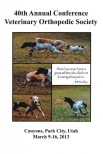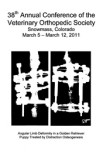Objective: To determine growth of the proximal tibial physis in the Labrador Retriever, a breed of dog at risk for rupture of the cranial cruciate ligament (CCL). Animals: Male Labrador Retriever dogs (n=6). Methods: Tantalum markers (0.5 mm diameter) were implanted in the right proximal tibial epiphysis and metaphysis of each dog at 16 weeks of age. Lateral and craniocaudal radiographic projections of the tibia were made monthly and longitudinal growth was assessed from radiographs; a growth curve was generated from the data. Data from dogs that had undergone proximal tibial epiphysiodesis (PTE) was compared with the growth curve to demonstrate if the growth curve accurately predicted changes in the growth associated with this procedure. Results: Growth rate of individual dogs decreased slowly and non-linearly over the 1st year of age. Growth from the proximal tibial physis is described. Conclusions: Growth of individual dogs described here follows the model of saltation and stasis. The growth curve generated predicted the change in tibial plateau angle (TPA) for two Labrador Retrievers that had PTE (±1°).
Growth dynamics of the canine proximal tibial physis.
Date
2011 June
Journal
Vet Surg
Volume
40
Number
4
Pages
389-94









